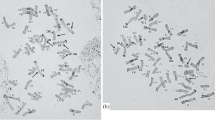Summary
Transmission of the extra (translocated) chromosome of tertiary trisomic T282W of rye (Secale cereale L.) upon seifing, through the male and/or the female, ranged from 0% to 36% in different inbred lines. Tetrasomics arising from simultaneous male and female transmission were not recovered and thus apparently not viable. Low seed weight, poor seed germination and a low transmission rate were correlated with low seed weight and reduced plant vigour. Inbreeding depression was concluded to affect transmission rate through its effect on the relative viability of trisomic seeds or seedlings.
Male transmission in testcrosses with disomics averaged 7%, but varied between lines. Genetic factors were involved, but their expression remains uncertain. Pollen quality, as determined by a fluorescence reaction, was somewhat lower in trisomics than in disomics of the same genetic background and was not correlated with male transmission rate, which appears to be determined mainly by relative pollen-tube growth of euploid and aneuploid gametophytes. The results are discussed in relation to the use of tertiary trisomics in balanced chromosomal systems for hybrid breeding.
Similar content being viewed by others
References
De Vries JN (1983) Sources of tertiary trisomics for balanced chromosomal systems in hybrid rye breeding. Can J Genet Cytol 25:622–633
De Vries JN (1984) Cytogenetic approaches to breeding and propagation of male sterile parent lines for hybrid varieties of rye. Ph.D thesis, Agricultural University, Wageningen, The Netherlands
De Vries JN, Sybenga J (1984) Chromosomal location of 17 monogenetically inherited morphological markers in rye (Secale cereale L.) using the translocation tester set. Z Pflanzenzucht 92:117–139
Goodspeed TH, Avery P (1939) Trisomic and other types in Nicotiana sylvestris. J Genet 38:381–458
Heslop-Harrison J, Heslop-Harrison Y (1970) Evaluation of pollen viability by enzymatically induced fluorescence: intracellular hydrolysis of fluorescein diacetate. Stain Technol 45:115–120
Heslop-Harrison J, Heslop-Harrison Y, Shivanna KR (1984) The evaluation of pollen quality, and a further appraisal of the fluorochromatic (FCR) test procedure. Theor Appl Genet 67:367–375
Janse J (1985) Relative rate of development of aneuploid and euploid microspores in a tertiary trisomic of rye, Secale cereale L. Can J Genet Cytol 27:393–398
Janse J (1987a) Male transmission of the translocated chromosome in a tertiary trisomic of rye: genetic variation and relation to the rate of development of aneuploid pollen grains. Theor Appl Genet 74:317–327
Janse J (1987b) Certation between euploid and aneuploid pollen grains from a tertiary trisomic of rye, Secale cereale L. Genome 29:353–356
Kamanoi M, Jenkins BC (1975) Studies on the trisomics in common rye, Secale cereale L. I. Their occurrence and morphological characteristics. J Agric Sci Tokyo Univ Agric 19:198–208
Khush GS (1973) Cytogenetics of aneuploids. Academic Press, New York London
Ramage RT (1965) Balanced tertiary trisomics for use in hybrid seed production. Crop Sci 5:177–178
Shivanna KR, Heslop-Harrison J (1981) Membrane state and pollen viability. Ann Bot 47:759–770
Singh UP, Sai Kumar R, Singh RM, Singh RB (1982) Tertiary trisomics of pearl millet (Pennisetum americanum) (L.) (K. Schun): its cytomorphology, fertility and transmission. Theor Appl Genet 63:139–144
Sybenga J (1958) Inbreeding effects in rye. Z Vererbl 89:338–354
Sybenga J, Wolters AHG (1972) The classification of the chromosome of rye (Secale cereale L.): a translocation tester set. Genetica 43:453–464
Sybenga J, Van Eden J, Van der Meijs QG, Roeterdink BW (1985) Identification of the chromosomes of the rye translocation tester set. Theor Appl Genet 69:313–316
Tsuchiya T (1960) Cytogenetic studies of trisomics in barley. Jpn J Bot 17:177–213
Wiebe GA, Ramage RT (1971) Hybrid barley. In: Nilan RA (ed) Barley genetics, vol II. Proc 2nd Int Barley Symp, Washington State University Press, pp 287–291
Author information
Authors and Affiliations
Additional information
Communicated by G. Wenzel
Rights and permissions
About this article
Cite this article
Janse, J., Sybenga, J. Generative transmission of the extra chromosome in a rye tertiary trisomic and its relation with inbreeding depression and pollen quality. Theoret. Appl. Genetics 84, 487–493 (1992). https://doi.org/10.1007/BF00229511
Received:
Accepted:
Issue Date:
DOI: https://doi.org/10.1007/BF00229511




